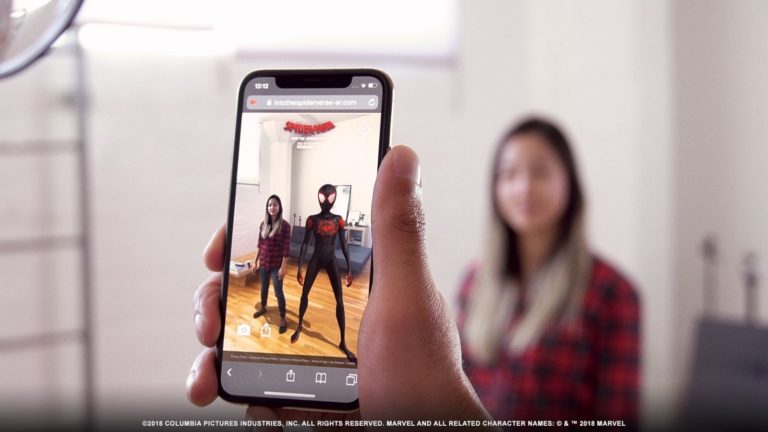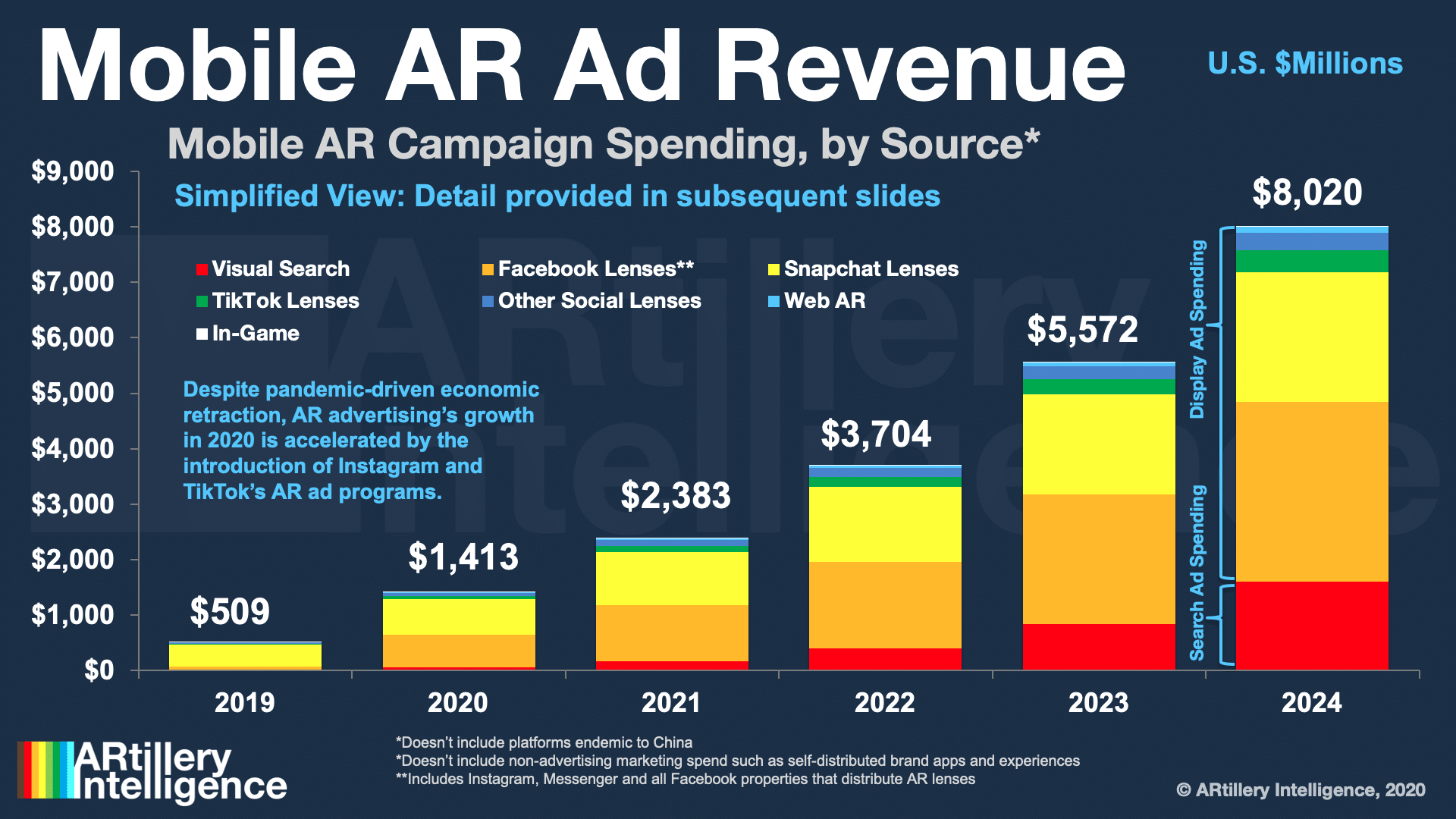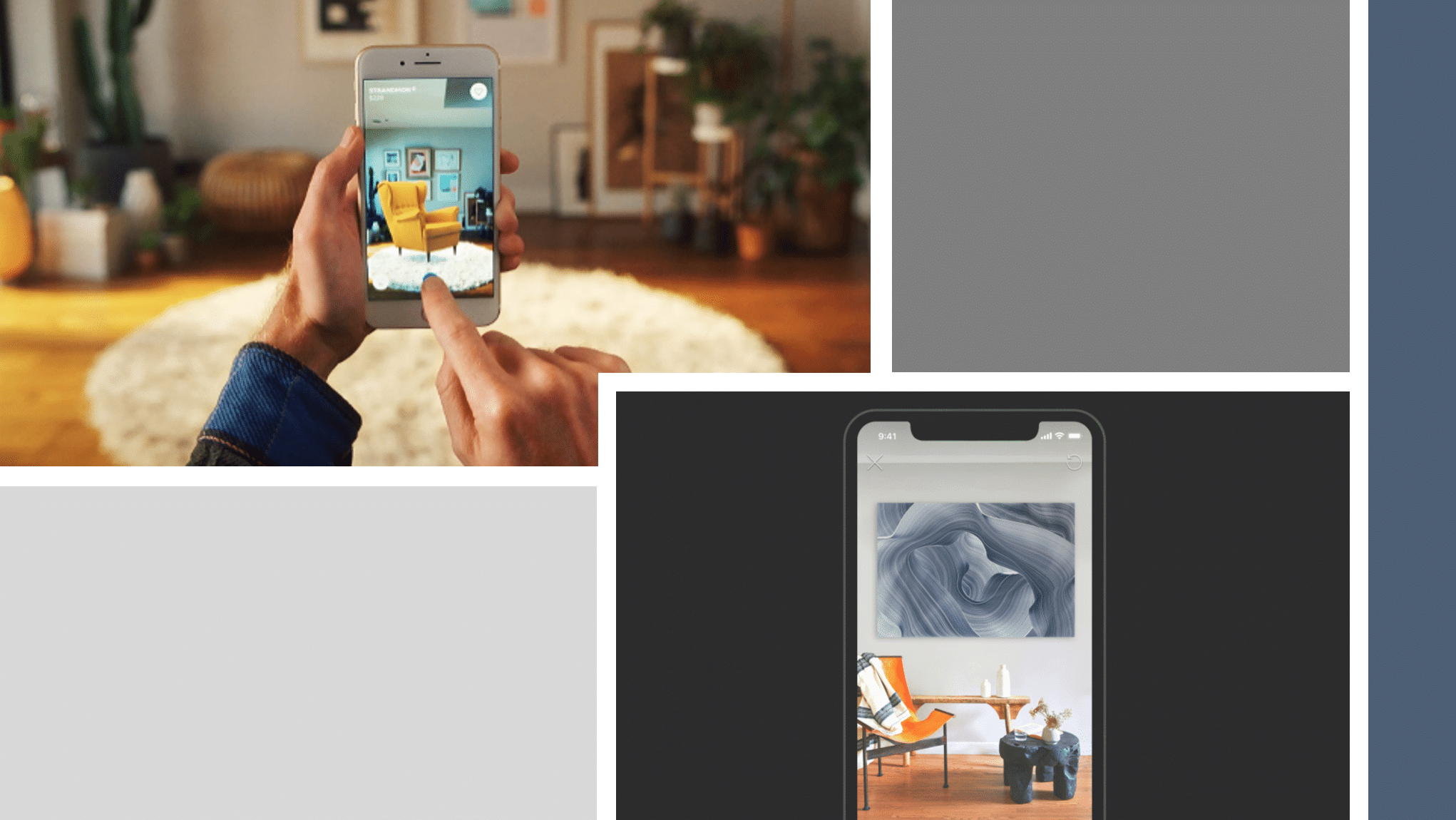
![]() This post is adapted from ARtillery Intelligence’s report, AR Advertising Deep Dive, Part I: The Landscape. It includes some of its data and takeaways. More can be previewed here and subscribe for the full report.
This post is adapted from ARtillery Intelligence’s report, AR Advertising Deep Dive, Part I: The Landscape. It includes some of its data and takeaways. More can be previewed here and subscribe for the full report.
AR continues to evolve and take shape as an industry. Prominent sectors include industrial AR, social, gaming, and shopping. But existing alongside all of them is AR advertising. This includes paid/sponsored AR lenses that let consumers visualize products on “spaces & faces.”
Advertising is one of the most lucrative AR subsectors, on pace to reach $1.41 billion this year and $8.02 billion by 2024. These figures measure the money spent on sponsored AR experiences with paid distribution on networks like Facebook and Snapchat.
As we’ve examined in past reports, the factors propelling this revenue growth include brand advertisers’ growing affinity for AR. Its ability to demonstrate products in immersive ways resonates with their creative sensibilities, transcending what’s possible in 2D formats.
Beyond that high-level appeal, there’s a real business case. AR ad campaigns continue to show strong performance metrics. This was the case in “normal” times and has accelerated during the COVID era, when retail lockdowns compel AR’s ability to visualize products remotely.

Optimal Vessel
Picking up where we left off last week, there’s growing realization that apps aren’t the optimal vessel for AR. Yet with mobile AR, it’s born on a device where apps rule. 90 percent of mobile users’ time is spent in apps versus the web. Can AR break that cycle?
Web AR resides within the mobile browser. Advantages include dynamism for AR’s serendipity and short sessions, versus the friction of app stores and downloads. All that “activation energy” dampens AR adoption, which is already challenged by its nascent and unproven status.
Will consumers spend 90 seconds downloading an app for an experience that lasts 30 seconds? Consider this in light of dynamic AR activations within a store aisle or sharing a new lens with a friend. These scenarios have implications for web AR’s reach and viability as an ad platform.
“Web AR has some nice advantages,” 8th Wall CEO Erik Murphy-Chutorian told ARtillery Intelligence. “You’re not tied into a social network. You’re not tied into a platform. You don’t have to go to an app store and you aren’t restricted on devices. You can get on most peoples’ phones.”
8th Wall’s eponymous 8th Wall Web is an AR engine that works on mobile browsers. Built on standards-compliant JavaScript and WebGL, it has SLAM, positional tracking and some of the trappings of “true AR” seen in native apps, but without the bloat and activation energy.
This approach has attracted Sony Pictures, Miller Lite, and Porsche as clients for AR campaigns. It powers more than 5,000 web AR apps and reports that 80 percent of its AR activations have session lengths greater than one minute, and 50 percent are greater than two minutes.
Native Advantage
As further background on apps versus web AR, Murphy-Chutorian admits that apps can have some advantages. For one, they can more-directly tap into device sensors when using a native platform such as ARkit that has purpose-built vertical integration with the hardware.
“Apple specifically has done a really good job of getting accurate scale in AR,” said Murphy-Chutorian “There are things like measuring if my suitcase fits inside a box, or virtual tape measures. They’ve done an excellent job getting the accuracy right for those things.”
As for practicality, apps work well when it’s something you use frequently, such as the small tray of daily-use apps like Facebook, email, messaging or games like Candy Crush. For these few use cases, home-screen positioning and quick access can be well served by native apps.
“Apps are really good for these things that you come back for all the time, like if you’re going to sit there checking your Facebook feed multiple times per day,” said Murphy-Chutorian. “It’s almost like apps are a commitment: once you have that level of commitment, they’re appropriate.”

Reach Advantage
Some of the above app advantages only apply to a limited set of high-use apps. For newer apps, getting into that exclusive club is very hard. So for any app developer building something today — especially in the still unproven AR category — the calculus is different.
“Say you’re a new company and you want to do something in AR… you build a native app and put it in the store. How many downloads do you get?” posed Murphy-Chutorian. “People really struggle to get their apps downloaded, and their reach and visibility is much smaller.”
But things open up a bit in web AR, as you can plant universally-operable web links as calls to action wherever you have presence. That includes brand marketing assets like product packaging It also includes the advertising distribution channels that are the focus of this report.
“Any source of traffic you have becomes an opportunity to show AR,” said Murphy-Chutorian. “Another great area for reach is people who own restaurants, stores or sell goods that are printed on anything. It’s AR on the back of the toy you just bought or the cereal box or Starbucks lid.”
Along with that comes functionality for all the things the web does, added Chutorian. If operating outside of apps or social walled gardens like Facebook, you can connect AR experiences to your payments processor as well as web-based tools like Google Maps API and Google Analytics.
“Those kinds of web combinations let you build much more powerful things than what you can do on AR apps and social networks.”
We’ll pause there and circle back in the next installment to continue the discussion of AR advertising players and formats. Meanwhile, check out the full report here.
